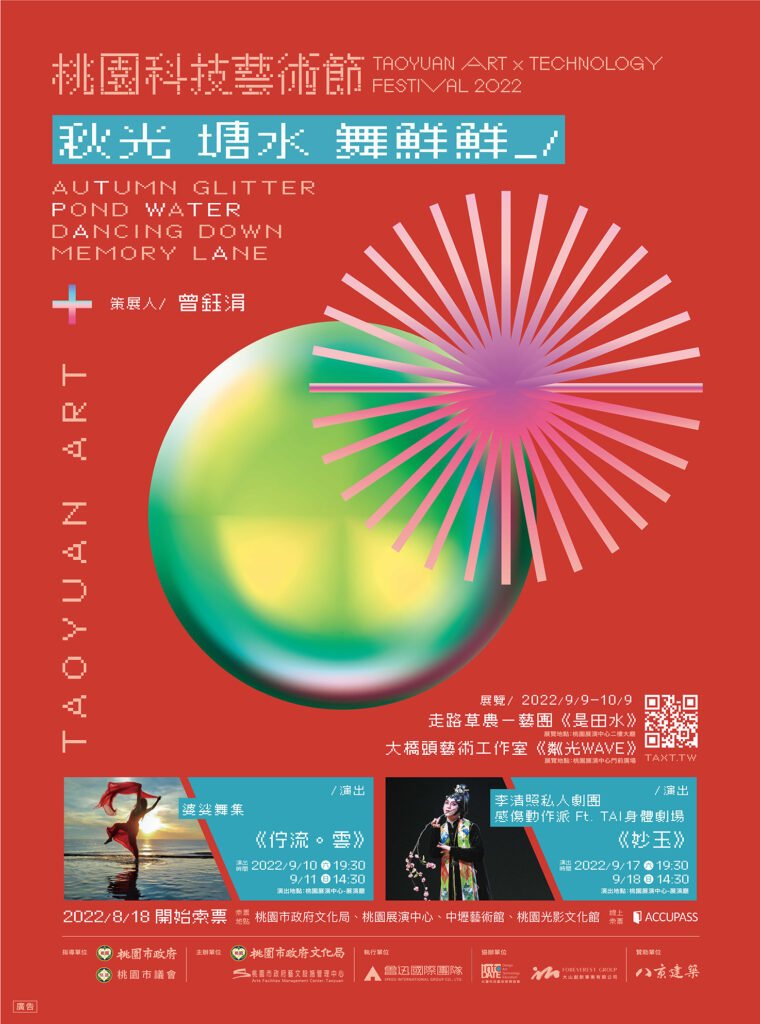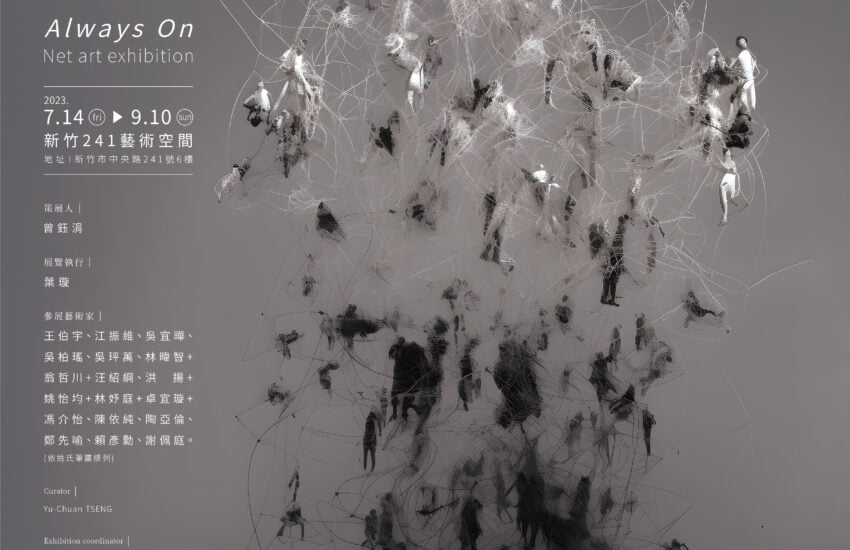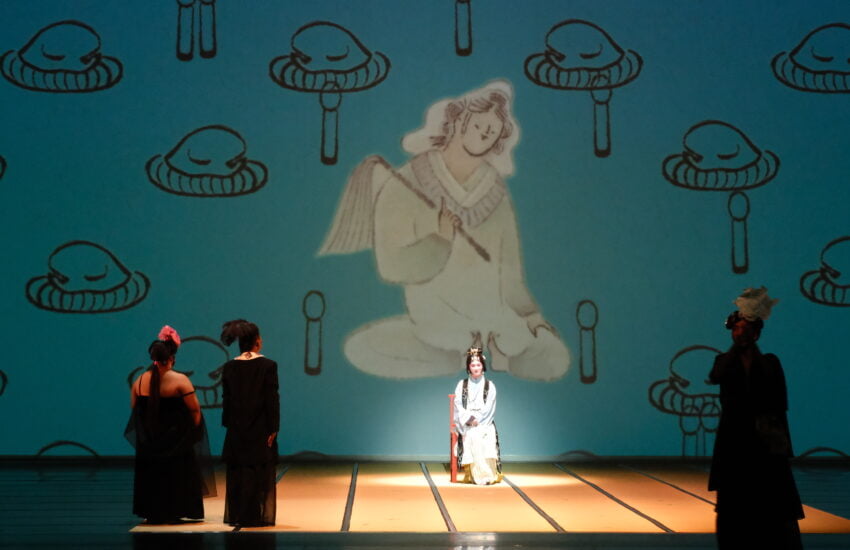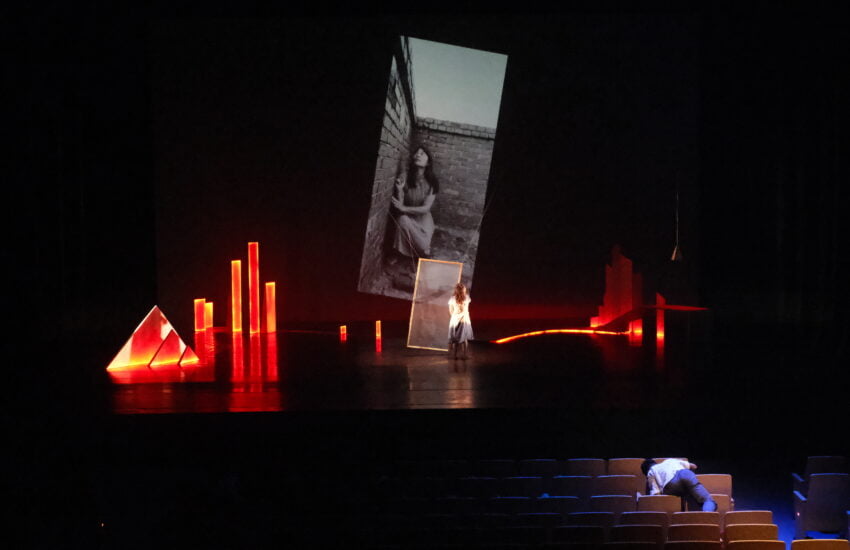2021 Taoyuan Art x Technology Art Festival- Autumn Glitter, Pond Water, Dancing down memory lane 桃園科技藝術節:秋光‧塘水‧舞鮮鮮
Curatorial Statement
With the glittering light of autumn and the ripping water in ponds, memory dances in the minds and becomes transparent stories.
Introduction
Autumn Glitter—
Autumn symbolizes time. It is a season of sorrow and suppression, but also the season of harvest.
“Autumn Glitter” is inspired by a couplet from chapter 38 of A Dream of Red Mansions: “The autumn’s time fleets, and ought not to be wasted. We ought to cherish every moment while in each other’s company.” It also responds to Yang Mu’s verse poem, “Miao-Yu’s Meditation,” in which the poet writes: “The layers of light and shadow are repeatedly twisted, compressed, and shattered into pieces.”
Cascading through leafless branches and withered leaves, the autumn glitter is splendid as dancing butterflies, and conveys a sense of warmth and a touching feeling.
Pond Water—
The glittering ponds of Taoyuan, praised as “the Home to a Thousand Ponds,” is the stage of Chung Chao-Cheng’s novel, Flowing Cloud. It is a site of memory, stories, and history, as well as a reciprocal system of regulation created for Taoyuan by Mother Earth. The water system sustains people’s lives, while creating a natural state that is full of vibrant life, forming a life network system.
Dancing down memory lane—
Memory constitutes of encoded and stored stories. The writing of stories indicates a process of searching and extracting memory in the brain, a mental activity of thinking and imagining. Messages of memory jump and recombine in the brain, and through dance and drama performances, new meanings are re-created. “Dancing down memory lane” beckons at the existence of and creation by women in time, and points to a transparent state of self-realization and self-transcendence.
With women in the literary texts as its theme, Autumn Glitter, Pond Water, Dancing down memory lane upholds the spirit of Total Artwork (Gesamkunstwerk), and employs dance and drama to explore the existence of and creation by women in life. With interactive installation works of technology characterized by an interplay of light and shadow, it represents the “ponds,” a local networked system of water, as a body of living consciousness, and reflects on the symbiotic relationship between the environment and life.
Women in the Text
Posuo Dance Company’s Standing Flow.Cloud is based on the character, “Yin-Mei”, in Chung Chao-Cheng’s Flowing Cloud, and re-considers women’s self-awakening and self-awareness in the patriarchal context. Theatre Company of LeeQingZhao the Private’s Adamantina, on the other hand, is adapted from Taiwanese poet Yang Mu’s classic long verse poem, “Miao-Yu’s Meditation” to portray the character, “Miao-Yu,” one of the twelve beauties of Jingling in A Dream of Red Mansions, and portray the possible actions and sentiments of Miao-Yu in the secluded mansion.
Although literary texts often feature the “existence” of women, female characters are often portrayed as lost, self-sacrificing, sorrowful and destructive individuals. However, the “existence” of women is often where the power originates, as well as what makes a novel appealing and attractive. In A Dream of Red Mansions, Miao-Yu is the daughter of an established family of elite government officials, and is described as “extremely beautiful, well-learned, and smart but also extremely un-sociable and proud, self-contained, and ungregarious. After the decline of her family, she does not fit into the society. So, in the name of spiritual practice, she moves into the Jia family, and lives in Longcui Nunnery in Daguan Garden.” In Chung Chao-Cheng’s Flowing Cloud, although Yin-Mei is a child bride, she is always adamant, diligent, courageous, and passionate. She is brave in pursuing love as well as giving it up to leave her home.
In her Reading the Romance Fictions by Chong Yao of 2006, Lin Fang-Mei states that one of the two ways to study the relationship between literature and society is to examine the social phenomena represented in a literary work, and reduces the literary work into an embodiment of a social concept. Literary works therefore serve as a channel to glimpse and examine the social milieu of a certain time. In literary texts, we can understand abstract social concepts and phenomena. In the times of Miao-Yu and Yin-Mei, women are “voiceless.” Demanded by social norms, women are supposed to become gentle wives and good mothers. In short, they are the subject of stories, as well as the object of the male gaze. However, both Miao-Yu and Yin-Mei have found a way to enjoy themselves in life. Whereas the former seeks to protect her own dignity in confinement, the latter takes action to flee from the restraints of traditional thinking.
Hilary Hart, in Body of Wisdom: Women’s Spiritual Power and How it Serves, reminds women to believe in their inborn power. Through discovering the power within their bodies, they can find firefly-like glimmers of light within themselves, which are women’s spiritual power. This spiritual power exists in their bodies and energy systems, and permeates their minds and souls. In the form of a network, it connects women’s bodies with all beings in the world, creating a massive whole. This concept echoes the notion of Mother Earth: In Chinese mythology, it takes the shape of Goddess “Nuwa”, and in the Greek mythology, “Gaia.”
“Nuwa” is a goddess in Chinese mythology with a human head and the body of a snake. She is known to refine five-colored rocks, which can be melted for mending the holes in the sky broken in the fight between “Gonggong” the god of water, and “Zhurong”, the god of fire. Nuwa also uses clay to make humans, creates marriage to continue the human life, and gives life to the sentient beings in the world. In Greek mythology, Gaia is the mother god of creation, who creates the primal gods and beings in the cosmos. In the notion proposed by James Lovelock in 1969, the planet Earth is a living consciousness, and constitutes a reciprocal or regulatory system. He names this notion the “Gaia Hypothesis,” which not only echoes to the idea of women as “Mother Earth,” but also corresponds with the qualities of women’s life and bodies.
A Life Network System Created by the “Ponds”
Mother Earth is a multi-dimensional, multi-layered whole, derived and created by the physical power of women. It transcends the isolating self, and even humanity itself, to continuously create throughout the succession of life. Mother Earth has carried out the mission of creation and nurturance for the planet Earth, constituting a reciprocal or regulatory system, while maintaining a stable state suitable for the growth of all life.
The “ponds” in Taoyuan, as a nurturing system for early settlers, were first created for the need to perverse water from the rain, streams, springs to supplement the irrigation of farmlands, and have consequently constituted the unique cultural and natural landscape comprising reservoirs, rivers, ponds, and irrigation canals. It is not only century-old, but also contributes to the formation of the unique natural ecological system and the culture of community life characteristic of the Taoyuan Plateau. Walking Grass Agriculture’s Sī Tshân-tsuí (Cultivable Land) focuses on “ponds and lupins,” and utilizes 3D scanning and printing technology, sensory interactive installation, and the expressiveness of metalsmith to create and preserve memory and culture through public participation. The work echoes the memory of the farmlands in Taoyuan, and initiates a dialogue with the earth. Studio BHA’s Wave amalgamates light structure installation and interactive control system to take abstract images drawn by the public with pond water, and transform them into a fluid landscape with rippling waves. The work features the “ponds” as the crystallization of our predecessors’ wisdom, while delineating the “ponds” as a feedback and regulatory system created for Taoyuan by Mother Earth. The water system, which sustains people’s livelihood and survival, has created a natural state brimming with vitality, and has become a life network system.
Conclusion
The Taoyuan Technology x Art Festival, with the amalgamation of technology and performing arts as its subject, translates women’s stories in literary texts to discuss the existences and creations of women in the progression of life, while employing technology art installations to portray the life network system in Taoyuan. Using co-creation workshops, mechanical motored installations, and light installation, the festival engages people in the practice of the public life. It is hoped that the contextualized planning of exhibitions and performances can enable interdisciplinary performing arts to evolve into the “Total Artwork,” which dissolves all boundaries between different art forms and become a “whole.” With technology as the instrument, stories as the contents, and performing and visual arts as the media, the strategic collaboration between art and technology combines visual, audio, physical, stage, interdisciplinary collaboration between artists, as well as the co-creative participation of artists and the public, to produce an art festival informed by narrative scenarios and characteristics of the Total Artwork.
Reference:
Lin, Fang-Mei (2006). Reading the Romance Fictions by Chong Yao. Taipei: Commerce Press.
Hart, Hilary (2017). Body of Wisdom: Women’s Spiritual Power and How it Serves. Beijing: World Publishing Corporation. Lovelock, James (1994). Gaia: A New Look at Life on Earth. Taipei: Commonwealth Publishing.
策展論述
秋天的光影、埤塘的水波、記憶在腦中跳舞成為清澈的故事。
前言
秋光:
秋天象徵時間,是悲傷和壓抑,卻也是豐收的季節。
秋光,來自於《紅樓夢》第三八回:“秋光荏苒休孤負,相對原宜惜寸陰。” 也回應楊牧 《妙玉坐禪》「折疊的光影不斷扭曲,壓縮,破碎。」
秋天的光影,在枯枝落葉之中灑落,斑斕如蝶,是溫暖與心動。
塘水
桃園「千塘之鄉」埤塘水光,是鍾肇政《流雲》故事發生的地點,是記憶故事與歷史的場景。也是大地之母於桃園所創造的回饋調控體系,維持人們生存所需的水文系統,創造出具生命力的自然狀態,成為一個生命網絡系統
舞鮮鮮:
記憶是將故事編碼與貯存,寫故事是將腦中記憶,進行腦中檢索與運作提取的過程,思維與想像的心理活動。記憶訊息在腦中跳躍重組,透過表演的舞與劇,重新建造出新的意義。鮮鮮是客語清清之意,象徵女性在時光更迭中的生命存在與創造,成就並超越自我的清澈狀態。
《秋光‧塘水‧舞鮮鮮》以文本中的女性為主題,以「總體藝術」的精神,以舞與劇,討論女性在生命過程中的存在與創造,以光與影的科技互動裝置作品,呈現在地水文網絡系統「埤塘」之生命意識體,思考環境與生命之間的共生關係。
文本中的女性
「婆娑舞集」《佇流。雲》以鍾肇政《流雲》中銀妹為本,重新思考在男性威權下的女性自覺與自我意識;李清照私人劇團《妙玉》則是以台灣詩人楊牧(1940-2020)發表於1985年經典長詩《妙玉坐禪》為文本改編,呈現《紅樓夢》十二金釵中妙玉故事,闡述妙玉居於深宅内院的可能行動與感懷。
女性在文學文本中”存在”為主角,卻往往被描述為迷失、委屈求全,或是充滿著悲痛與破壞性的個體。然而,女性的”存在”,卻是力量之所在,是小說文本吸引人之處,紅樓夢中的妙玉中,是仕宦人家的小姐,被形容為:「極端美麗、博學、聰穎,但也極端孤傲、清高、不合群,因為家道敗落,不為世俗所容,假修行之名,投奔賈府,居於大觀園中櫳翠庵。」鍾肇政《流雲》中的銀妹雖是童養媳,卻充滿著堅強、勤勞、勇敢與熱情,勇敢追愛卻也放棄愛情,離家遠去。
2006年林芳玫在《解讀瓊瑤的愛情小說》一文中提出,文學與社會關係研究的兩種取向之一是檢視作品內容中所呈現的社會現象,將文學作品化約為社會概念的具體化。文學作品是檢視當時社會情境的一種管道,在文本中可以了解到抽象的社會概念與社會現象。妙玉與銀妹所屬的時代,女性是處於被「禁言」的狀態,女性被要求依照社會規範,成為賢妻良母,他們是故事中的主體,也是男性凝視觀看的客體。然而,妙玉與銀妹卻又能在自得其樂,前者在禁錮中尋求維護自我的尊嚴,後者以行動逃離傳統思維的桎梏。
希拉里・哈特(Hilary Hart)在《女性的身體智慧》一書中,提醒女性要相信自己的天賦之力,透過女性自己身體的力量,發現自己身上如同螢火蟲的細小閃光點,那是女性的靈性力量,存在於身體與能量系統當中,滲入我們的心靈與心智,如同網絡一般,將身體與萬物連結一起,成為一個整體。此概念可以呼應大地之母:中國神話中的女神「女媧」與希臘神話中的蓋婭(Gaia)。
「女媧」是中國神話故事中,人首蛇身的女神,煉製各種各樣的五色石子,將其熔化成漿後,修復水神共工與火神祝融爭鬥中,所造成的殘缺天窟窿,並摶土造人,制嫁娶之禮,延續人類生命,造化世上生靈萬物。希臘神話中的蓋婭(Gaia)則是古希臘神話中的大母神,創造了原始神祇和宇宙萬有的創造之母。1969年詹姆士˙洛夫洛克(James Lovelock)提出地球是一個具有生命的意識體,構成一個回饋或調控系統,並命名此假說為蓋婭假說(Gaia Hypothesis),此命題不僅呼應女性為大地之母一詞,也回應女性的生命與身體特質。
生命網絡系統「埤塘」
大地之母是從女性的身體力量所延伸所創造的一個多次元、多層次的整體,超越了孤立的自我感,甚至超越了人類本身,在生命間的傳承演變中創造。大地之母為地球上執行創造與滋養的任務,構成了一個回饋或調控的體系,維持適合一切生命成長的穩定狀態。作為桃園早期到此開墾者的滋養系統的「埤塘」,是為了貯留雨水、溪水、泉水補充農田灌溉所需所產生。此特殊的地質景觀,形成特殊的水庫、河川、埤塘與水圳所建構而成的人文自然地景,不僅具有百年的歷史,也建構出桃園臺地特殊的自然生態體系與聚落生活文化。走路草農/藝團《是田水》,以「埤塘與魯冰花」為主題,以3D掃描列印科技、互動感測裝置與金屬工藝表現結合,將記憶與文化透過民眾參與一起創造保存,呼應這片田水的記憶,並與大地對話。大橋頭藝術工作室《粼光 Wave》,以光結構裝置、互動控制系統,將民眾以埤塘水為材料所描繪之抽象影像,變換成波光粼粼的流動風景。作品呈現「埤塘」是先人的智慧,也是大地之母於桃園所創造的回饋調控體系,維持人們生存所需的水文系統,創造出具生命力的自然狀態,成為一個生命網絡系統。
結論
桃園科技藝術節將以科技跨界表演藝術為主體,透過文本中女性故事的轉譯,討論女性在生命過程中的存在與創造,並以科技藝術裝置作品,呈現在地的生命網絡系統,並透過共創工作坊、機動裝置、與光影裝置,將民眾帶入公共生活的實踐。期待能透過具脈絡性的展演規劃,將跨界表演藝術進化為讓所有藝術間的界線消失成為「整體」之「總體藝術」。科技是工具,故事是內容,表演與視覺藝術是媒介,透過藝術與科技的合作策略,將視覺、聲音、肢體、舞台,藝術家們的跨界合作,藝術家與民眾的共創參與,一起完成具故事情境,且具總體藝術特色的展演。
參考資料
林芳玫 (2006)。解讀瓊瑤愛情王國 。台北:臺灣商務印書館。
希拉里・哈特。 (2017)。女性的身體智慧。北京:世界圖書出版公司。 詹姆士˙洛夫洛克(1994)。蓋婭˙大地之母:地球是活的!。台北:天下文化




